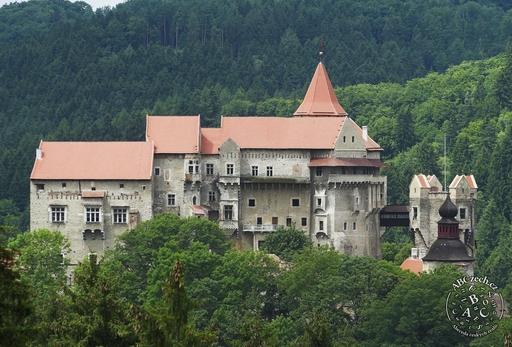
Ruins of an Early Gothic castle, approximately 6 kilometres from the town of Doksy. It is one of the most important medieval Czech monuments and a prime example of Central European fortification architecture of the 13th century.

A water fortress converted into a castle and later into a chateau in the eponymous town in the South Bohemian Region. It is one of the few surviving water residences in the Czech Republic and an exceptional example of a late Gothic aristocratic residence.

A monumental cathedral in Kutná Hora, joining the best traditions of Central European High and Late Gothic. It is one of the most ambitious and artistically demanding medieval buildings in the Czech lands.

Cathedral church on top of the Petrov promontory in the centre of Brno. The centre of the Brno diocese and a dominant feature of the city panorama.

Complex of the former medieval convent in Prague, also called “Na Františku”, in which one of the oldest Gothic buildings in Bohemia is located. It was one of the most important Czech convents in the era of the kings from the Přemyslid dynasty.

Benedictine monastery, founded by Charles IV in Prague’s New Town. It became famous primarily as the centre of Slavonic education and art, and is also one of the prime examples of art of the era of Charles IV.

One of the largest castle ruins in the Czech Republic. It is located near the town of Týn nad Bečvou in the Olomouc region and is famous primarily for its grandiose fortifications.

Medieval church in the historic centre of Brno. It was the centre of religious life for centuries and it is now one of the most important Late Gothic buildings in Moravia.

One of the most famous and most frequently visited castles in the Czech Republic with exceptionally valuable Gothic interiors. It is located in the Central Bohemian Region, approximately 30 kilometres southwest from Prague.

The oldest preserved building of Charles University and its current representative seat. It has preserved a lot of its original Medieval appearance and is one of the most valuable buildings of its kind in Europe.

A well-preserved castle in central Bohemia. It is one of the oldest royal castles and an exemplary work of Late Gothic castle architecture.

The most significant artistic and architectural monument to Jewish burial culture on the territory of Prague. The cemetery complex is a unique collection of exceptionally valuable Renaissance tombstones. It is a part of the oldest Jewish urban settlement.

Early Gothic synagogue in the Josefov quarter Prague, exceptionally well preserved in its authentic appearance, and the oldest continuously functioning synagogue in Europe.

Important 15th-century industrial and cultural monument in Děčín. It is decorated by sculptures of Saint John of Nepomuk, Saint Vitus and Saint Wenceslas.

Historic town hall of the Old Town, located in the Old Town Square in Prague. It is the oldest town hall in the Czech Republic and one of the most important monuments of the Historic Centre of Prague.

Architect and sculptor who worked mostly in Bohemia. One of the most important representative of European Gothic, famous as the builder of the Prague Cathedral of St. Vitus and Charles Bridge.

An exceptionally well-preserved castle near the town of Nedvědice in the eastern part of the Bohemian-Moravian Highlands. It is one of the most valuable castles in Moravia.

Medieval monastery in the Předklášteří municipality, approximately 2 kilometres from the town of Tišnov. It is one of the oldest and architecturally most valuable Early Gothic monuments in the Czech Republic.

The largest castle ruin in the Czech Republic, located in the eponymous town in Plzeň Region. It is famous for its massive fortifications, which were some of the most advanced in the country at the end of the Middle Ages.

The largest and most important church in the Czech Republic, a dominant feature of Prague Castle and one of the symbols of Czech statehood, in which kings of Bohemia were traditionally crowned and buried.
2016-2020 ABCzech.cz - © Filozofická fakulta Univerzity Karlovy
Content from this website may be used without permission only for personal and non-commercial purposes and with the source cited. Any other use is allowed only with the authors' consent.
This web application Sonic.cgi meets GDPR requirements. Current information can be found here.